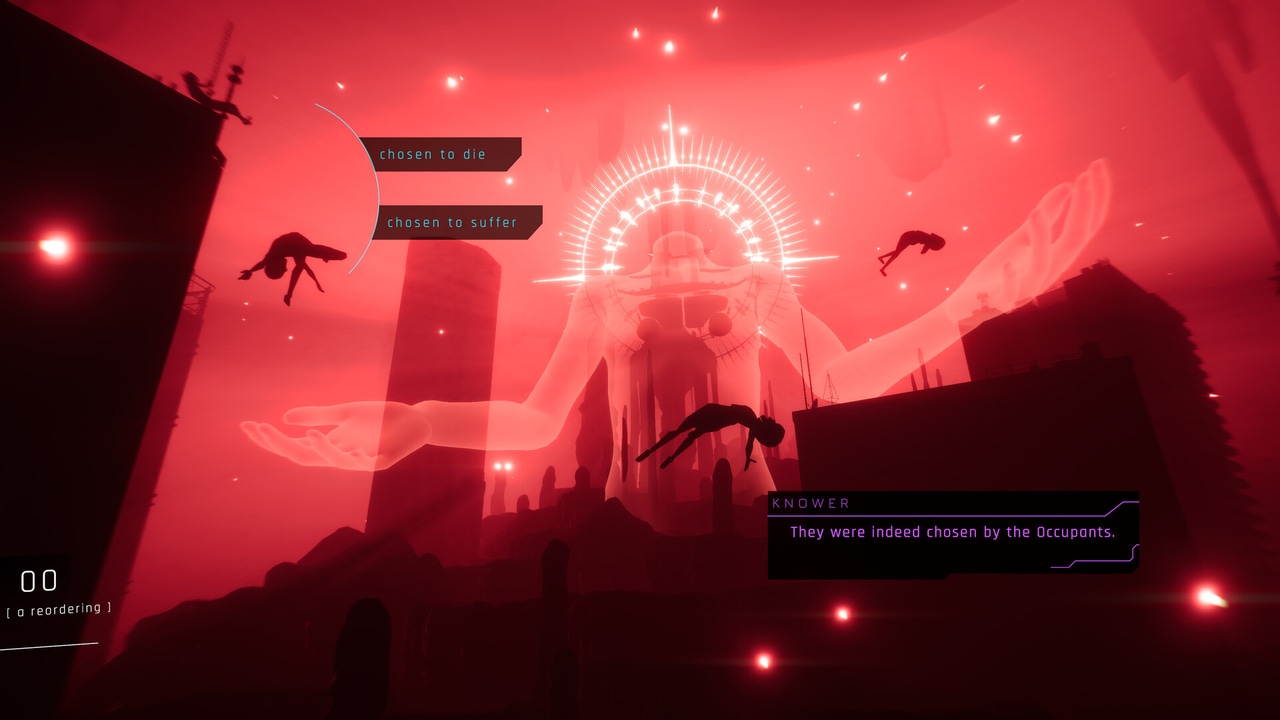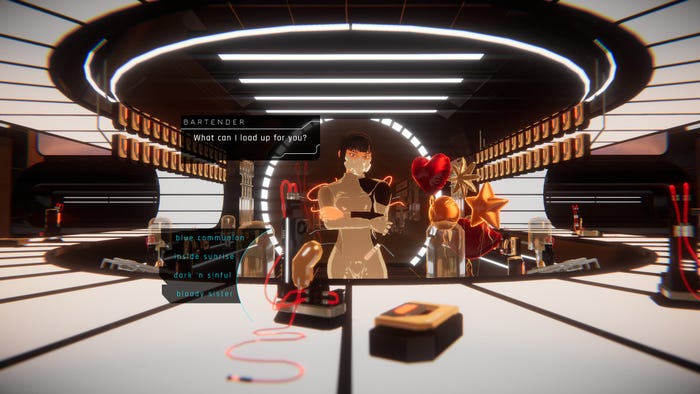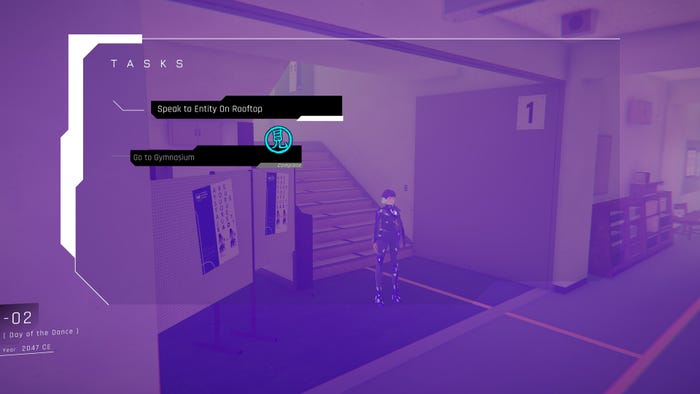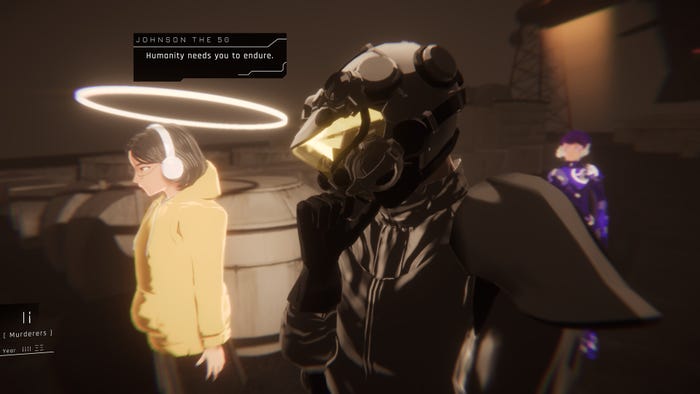Trending
Opinion: How will Project 2025 impact game developers?
The Heritage Foundation's manifesto for the possible next administration could do great harm to many, including large portions of the game development community.

Developer Remy Siu talks about how a variety of talents and backgrounds helped their studio come up with compelling ideas for their futuristic thriller.

The IGF (Independent Games Festival) aims to encourage innovation in game development and to recognize independent game developers advancing the medium. Every year, Game Developer sits down with the finalists for the IGF ahead of GDC to explore the themes, design decisions, and tools behind each entry. Game Developer and GDC are sibling organizations under Informa Tech.
1000xRESIST sees players looking at the past to solve puzzles in a distant apocalyptic present, steadily trying to unveil the lies upon which your diseased civilization is built.
Game Developer caught up with the game’s creative director, Remy Siu, to talk about spinning things that are considered “normal” in the present into something unexpected in the far future, the musical concept that helped inspire the game’s shifting, overlaid timelines, and how having developers with backgrounds in dance, theatre, music, and more would give them compelling new ideas to shape this complex adventure.
Who are you, and what was your role in developing 1000xRESIST?
I’m Remy Siu, the creative director of 1000xRESIST and Founder of sunset visitor 斜陽過客.
I grew up playing video games and always wanted to make them, but in the 90s, there was no immediate way to do that for a kid, so I decided to make art in whatever way I could.
I spent a lot of time writing fiction, doing the “2000 words a day” for most of my teenage years and into my early 20s. At school, I studied acoustic and electroacoustic music composition. After graduating, I shifted to “new media art” and creative coding, using things like Isadora, VVVV, and TouchDesigner to create multimedia performing art works for stage.
Between 2013-2020, I started a non-profit arts company with my friends called Hong Kong Exile (Natalie Tin Yin Gan, one of our writers, is one of the co-founders) and created my own work. During that time, I also had a gig as the curator of Contemporary Musiking Hong Kong (started by sound artist Samson Young) and was a composer-in-residence at the National Arts Centre Orchestra (of Canada).
The COVID-19 pandemic shut down a lot of these activities. Suddenly, there was no travel, rehearsals, performances, or festivals. So, without anything to do, I started working on the original prototype of 1000xRESIST, pitching it to publishers, and applying for funding. After several months navigating those waters, I signed with publisher Fellow Traveller, received funding from the Canada Media Fund, and started a studio.
Like many small indie teams, everyone at the studio wears a lot of different hats. My most consistent roles on the game were: 1) Unity Generalist, building the game in-engine (but not programming), designing the flow of “levels,” and whatever comes up that needs to be done, 2) Directing the macro form of the game, writing dialogue, editing, and working closely with the writers, and 3) Directing the voice actors during recording.
What's your background in making games?
I definitely did not have a background in making “traditional video games” before starting 1000xRESIST. I guess, when I was younger, I made a lot of StarCraft maps for myself to play. In my work for stage, I used real-time game mechanics (programmed in TouchDesigner) to govern performances. That was maybe the first step into thinking about making a full game. The other step was learning Unity to create gallery installation work and performances.
I did play a lot of games a lot of the time—as many different types as I could—and tried to stay up to date with new indie releases. Early on, it was a combination of Kentucky Route Zero and the KILL SCREEN magazines that made me think about "video games" as an avenue for creation again. It was inspiring to see small teams making such amazing experiences and to see such thoughtful writing on games.

Images via sunset visitor 斜陽過客
How did you come up with the concept for 1000xRESIST?
Coming up with ideas or concepts is a pretty non-linear process for me. Usually it’s a lot of disparate ideas floating around that eventually coalesce into a more solid idea, shaped by hard real-world constraints. In the case of 1000xRESIST, it was definitely the feeling of being isolated for months and months on end, being alienating from the very recent past, the many sci-fi ideas I’ve had pent up for years, the music I was listening to at the time, the kinds of lateral violence occurring in the arts community, the events occurring in Hong Kong—experiencing those events cut off from the place—and the very practical concerns of what I could achieve with the prototype alone.
From all this, there are usually a few “slices” that emerge. A human from the future visiting a terminal patient in the hospital and then looking out the window to see a strange figure. Something like this. Then, a lot of it is iterating and playing around to understand that “slice,” much like we do in experimental devised performance. Spending a lot of time finding the “timbre,” the right combination of mood, gesture, music, and narrative. It was about discovery as opposed to already having a destination. That became doubly true when the full team came on and production started proper.
What development tools were used to build your game?
We used the Unity built-in render pipeline (but sometimes wish we used URP [laughs]). We also use PlasticSCM for version controlling anything and everything, and Parsec for remote desktop-ing.
Kodai Yanagawa (Art Director) uses Photoshop to 2D concept characters and environments, and then Blender to build them out in 3D. He also uses AfterEffects for designing/concepting motion graphics for UI. I had experience using the Rokoko Motion Capture Suit for a previous project, so we did a lot of motion capture for 1000xRESIST.
For voiceover recording, we use Adobe Audition since I love the way it manages audio files. We also built our own little tool that auto-names all the files for input into the game (saves an enormous amount of time). For video and making trailers, we use Final Cut Pro and OBS to record gameplay. For writing, we use Miro a lot to plot out, brainstorm, etc. For production, we use Notion to keep track of everything.
1000xRESIST features a complex, unsettling vision of a future after humanity's near-destruction. Can you tell us about the thoughts that went into weaving this world, visually and narratively?
One of the “timbres” I gravitate toward is when something that is known by the audience to be one thing is taken out of context and mutated into something with a life of its own. A good example of this is in the final episode of Adventure Time (original series). It’s far into the future and BMO can’t remember their “best friend’s” name and recalls Finn as “Fred.” Or Simon (Ice King) in his museum stall with Cheers on repeat (in Fiona and Cake). Those are both hilarious and terrifying.
We were always looking for moments like this, where something very normal or known to us, something we may take for granted in the present, gets taken and spun out into the far future with strange consequences. Normal things to us become myths or strange repetitions. Later on in the game, we try to make it come full circle too.
For the clones that live in the future, we worked on spinning out their culture as some variation of this—values and things and ideas that are misremembered and lead to dangerous outcomes.
Visually, we wanted to bake a sense of longing and liminal space into the future environments. Kodai Yanagawa (art director) and I were calling a lot of these future spaces, "transitcore"—some combination and blur of all these public metro/transportation spaces. This sense of "going somewhere," but being stuck.
Can you talk about the ideas that went into the visual design of the alien Occupants? What specific ideas went into creating these otherworldly beings?
The earliest iteration of the Occupant was in the prototype. It was headless and shaded all in red. Also, all the motion for it, at the time, was captured by dangling the Rokoko Motion Capture suit without a body in it—creating this kind of sickening effect and motion.
When we started working on the full game, I drew a very bad stick figure and described it to Yanagawa and he just took it and ran with it. He quickly made a sketch and nailed it, and it hasn’t changed since. We were influenced by Evangelion angels, of course, and also the ornate halos in older paintings.
As to why they look the way they do—that’s a spoiler [laughs].

Images via sunset visitor 斜陽過客
In this title, players act as the Watcher, a being who can explore the memories of a powerful being, the ALLMOTHER, in the game's world. To do this, they can bounce between the present and the ALLMOTHER's memories. What ideas went into creating a seamless connection between her memories and the present that players could flick back and forth through? What ideas went into creating such a strong connection between memory and the present?
I think the time-jumping mechanic came back to this feeling of being alienated by the very recent past during the pandemic. I also love stories that are told out of chronological order. The time-jumping mechanic really expanded our narrative tools in a big way.
In music, there is this understanding of “intervallic relationships,” the distance between notes that sound simultaneously, or occur after each other. We thought a lot about what events in the timeline to stage—what “scale” or “mode” we were playing in, and the distance between each event—and then how to traverse that space sequentially—a melody of sorts. A memory might have a lot of events clustered together in chronological time, but we may be jumping from those events to much further far off events, for example. Lots of small intervals, then a huge leap.
We were also heavily influenced by the Star Trek: Deep Space Nine episode “The Visitor,” where Sisko is displaced in time, experiencing his son growing old without him. Slaughterhouse-Five, season 5 of LOST, Adventure Time, that time-jump in Battlestar Galactica, the discontinuity and ambiguity of “In The Mood For Love,” the Phoenix Manga by Osamu Tezuka, are some works that gave us some insight on how to approach this “time jumping” mechanic narratively.
Additionally, as the writing team consists of all first-generation immigrants, we grew up constantly being told about our connection to the past and culture—to hold or keep that connection in whatever ways we can. As diaspora, we are well acquainted with the feeling of this slipping away, always engaging with the question of what we take forward with us and what we don’t. Choosing what to keep as we move forward is one of the big themes of the game and the time-jumping mechanic really helped us hone in on this.
What development challenges/limitations or interesting opportunities came about from tying these two periods so closely together? How did the overlaid timelines affect the design of the game?
There were a lot of challenges. How do we make these big jumps in time feel comprehensible? How do we re-dress the same environment and make it feel familiar, but very different? How do we make the distant past and distant future feel distinct?
Technically, it was also a huge challenge working this way. Colin MacDougall (our one and only programmer) had to create a suite of tools for us to create these timelines, as well as all the gameplay/physics requirements to make this work in runtime in a performant and user-friendly way.
In the Unity editor, everything is just overlapped on top of each other until we use this tool to “filter” the timelines, which changes the skybox, the lighting, the rendered objects, the environment, etc. One of our chapters has like 60 timelines in them and a bunch of environments overlaid on top of each other—the editor kept stalling. It was a nightmare to work in [laughs].
It also locked us out of some built-in tools. For example, we had to spin up a custom variant of occlusion culling to respect the time periods and we couldn’t rely on baked-lighting out of memory concerns (and others). We were exposed to some assumptions made in Unity—this is “one place” and it is “now,” it has these things, this skybox, this ambient lighting, etc.—that didn’t really work for us. The game also has multiple control schemes: third-person, first-person, side-scrolling, fixed camera—so add in all of those complexities with the time-jumping. A lot of time was spent accommodating the timelines and I give all the credit to Colin for making it work.
In the end, the overlaid timelines affected the design greatly, especially once the writers and I got used to working this way. I think we settled into a groove, using them to unfold the story in a way that is unique to the medium—which was exciting. We see time jumps and cuts happening in film all the time, but a big part of the storytelling in 1000xRESIST is traversing across time and space and creating connections.
What thoughts went into designing puzzles that could be solved by delving into memories? How did you create mysteries players could only solve by bouncing between timelines?
As the game progresses, the timelines move away from a mechanical thing and melt into this formal narrative thing. Early in the game, we wanted these “puzzles” to create a sense of “normal gameplay” for the players, but quickly started to try to subvert and iterate on the possibilities of the concept. What does it mean for you to have control of the timelines and then have that taken away? What could the timelines stand-in for in different memories? How about many timelines in a small space vs. a few timelines in a big space?
For us, the most exciting part was to create these disparate points in time and have the players begin to guess what happened in between, both emotionally for the characters and literally for the lore. We do that from a narrative macrostructure place and the timelines are this more micro version of that. Trying to create greater mystery and then trying to create moment-to-moment mystery and friction to compel the player forward. It also allowed for uncanny parallels to be drawn between past and future, and this spoke to some of our broader themes of legacy, intergenerationality, inheritance, etc.

Images via sunset visitor 斜陽過客
How did you weave a complex storyline and years of lore and history into 1000xRESIST without making it feel overwhelming for the player? How do you spread that information across a sprawling sci-fi world in a way that makes it feel alive rather than a place filled with information dumps?
Personally, I really love stories that just toss you in and become clearer slowly as you progress. We worked really hard in the writer’s room to not info-dump, while being very upfront with the emotional stakes/scenario. To tell the players about the world through the way the characters behave, how they say something, and how they react to something.
For us, part of the Asian experience/expression and non-western storytelling is that there’s a lot said in what is NOT said. It’s a very difficult balancing act though, trying to make sure the player knows enough to somewhat understand, while pacing dramatic reveals for later. It’s us trying to do our best to make every line of dialogue either 1) create/expand mystery 2) touch on thematics 3) tell us something about the characters 4) move the scene/story forward in some way—all four at the same time, if we’re lucky, and if we could do it all in the subtext, even better!
We knew 1000xRESIST would be fully voiced from the beginning. We also started to record dialogue while we were still writing. One of the tenets that we followed was, “give the actors something to do.” If a line of dialogue, or a scene, is prescriptive about how it needs to be read, it’s not as fun to perform, I think. We wanted to give space for the actors to provide new information that was not literally spelled out on the page. This would lead to new discoveries for all of us, informing what we would write next.
So, a lot of lore was built and changed as we wrote into the story, as opposed to before. A lot of it is discovered through writing the characters and recording them. I think that goes back to the devising and “playful process” aspect of making this game.
Your team comes from a variety of backgrounds—dance, theatre, music, film, visual arts. Can you tell us how that variety of experiences would shape 1000xRESIST into something unique? How these various art styles would shape the game in compelling ways? And can you give some specific examples without spoilers?
I think our Art Director, Kodai Yanagawa, is a genius—he just has a way of making things affectual. His background is in animation, design, and illustration. All the future environments and character designs really inspired us as writers to keep up, but as a small team, we always had to get creative with the ways we depicted things.
Early on in the game, in Chapter 1, a character named Jiao is running away from the player. She is angry at the player character, but meanwhile, is also falling sick to a disease. There’s a version of this where we make her run from you and you see her in motion, but that didn’t feel right. Instead, we created multiple timelines for the player to flick back and forth between, to see her in various deteriorating states. There’s a bit of tableaux and stage lighting here – we would do this a lot in our previous performing art works, using bodies and light to define different “spaces” on stage in an abstract way. This, paired with the timeline system, kind of led us to an early discovery of fun ways we could use timelines to depict action and story.
In general though, it’s hard to define moments where we “inject” dance or theatre or music, here or there. I think a lot of it has to do with our backgrounds, training, and internalizing (and unpacking) all that we learned in the years we practiced, carrying it forward in how we think and solve problems, especially problems of scope. Many times in the writers’ room, if we’re stuck on a problem, we refer to previous works we’ve seen on stage, on screen, in games, etc. to understand how to solve our issue.
For myself, studying western music composition—“aesthetics” across many artistic movements is not how something sounds, but largely how material is chosen and then organized, and what processes are undertaken. So, there is a lot of knowledge and information about how to organize time and “work” on all scales in music. I used this background a lot to help guide me in thinking about how the memories are structured and how the game as a whole is structured.
What things do you hope the player takes away from this vision of the connection of past and present, as well as the exploration of how the world we feel we know may be built on lies?
I hope players are surprised more than a few times, I hope the story goes to places they don’t expect. I'm a sucker for when the past, present, and future collide in ways that resonate, so I hope they get to feel that a bit while playing this game.
You May Also Like